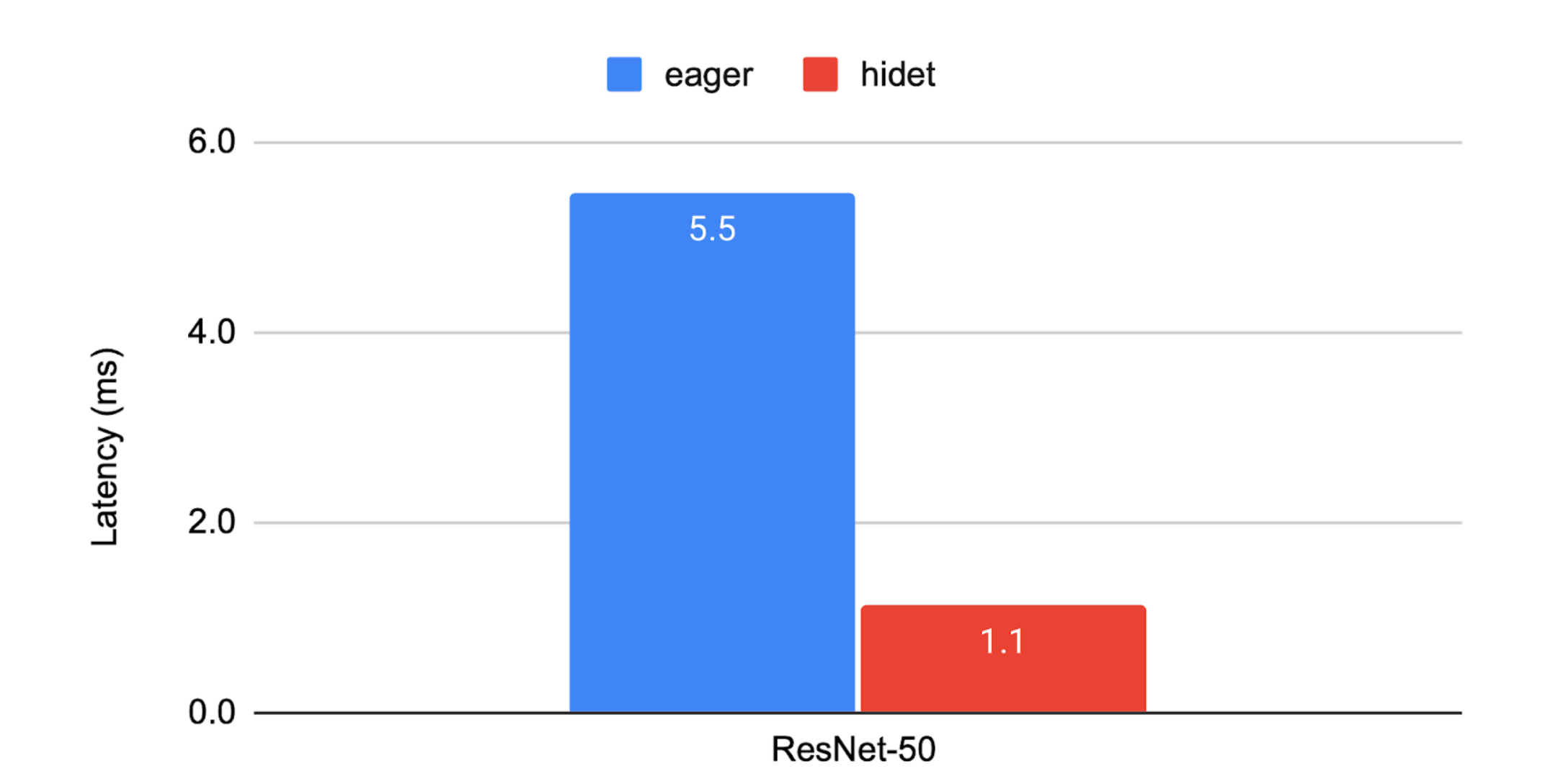Hidet 是一个强大的深度学习编译器,它简化了在现代加速器(例如 NVIDIA GPU)上实现高性能深度学习算子的过程。借助 PyTorch 2.0 中 torch.compile(...) 的新功能,将新编译器集成到 PyTorch 中比以往任何时候都更容易——Hidet 现在可以作为 torch.compile(...) 的后端来加速 PyTorch 模型,这使其成为希望提高模型推理性能的 PyTorch 用户的理想选择,特别是对于那些还需要实现高度优化自定义算子的用户。
使用 Hidet 编译 PyTorch 模型
要在 PyTorch 中使用 Hidet,您需要首先通过 pip 安装 hidet 包
pip install hidet
Hidet 按照 自定义后端教程 的说明,作为 torch.compile(...) 后端集成到 PyTorch 中。您可以在编译模型时将 hidet 指定为 backend。(注意:需要 PyTorch 2.0+ 版本)
torch.compile(..., backend='hidet')
Hidet 将给定 PyTorch 模型以 torch.fx.Graph 格式转换为其内部图表示,并进行一系列优化。Hidet 提供了一些选项来配置优化。例如,我们可以使用 hidet.torch.dynamo_config.use_tensor_core(True) 允许 Hidet 生成利用 NVIDIA GPU 上的 Tensor Core 的 CUDA 内核,并使用 hidet.torch.dynamo_config.search_space(2) 允许 Hidet 搜索最适合您的硬件和输入大小的算子调度。更多配置可以在 Hidet 的文档 中找到。
以下是如何使用 Hidet 编译和优化来自 torchvision 的预训练 ResNet50 模型的完整示例
import hidet
import torch
# Load a pre-trained ResNet50 model
x = torch.randn(1, 3, 224, 224, device='cuda').half()
model = torch.hub.load(
'pytorch/vision:v0.6.0', 'resnet50', pretrained=True
).cuda().half().eval()
# Configure hidet to use tensor core and enable tuning
hidet.torch.dynamo_config.use_tensor_core(True)
hidet.torch.dynamo_config.search_space(2)
# Compile the model using Hidet
model_opt = torch.compile(model, backend='hidet')
# Check correctness
torch.testing.assert_close(actual=model_opt(x), expected=model(x), rtol=1e-2, atol=1e-2)
# Benchmark
from hidet.utils import benchmark_func
print('eager: {:2f}'.format(benchmark_func(lambda: model(x))))
print('hidet: {:2f}'.format(benchmark_func(lambda: model_opt(x))))
我们鼓励您在自己的 NVIDIA GPU 上尝试上述脚本!如果您在 aws.g5.2xlarge 实例上运行此脚本,您将获得下图所示的结果。Hidet 实现加速的原因是它可以自动融合多个算子、调整算子调度并使用 CUDA Graph 来减少框架级开销。更多结果可以在 Hidet 的 ASPLOS’23 出版物 和我们的 性能跟踪 中找到。

使用 Hidet Script 编写自定义算子
Hidet Script 是一种在 Python 中实现张量算子方法。以下示例展示了如何使用 Hidet Script 实现一个朴素的矩阵乘法并将其集成为 PyTorch 算子。
import torch
import hidet
def matmul(m_size, n_size, k_size):
from hidet.lang import f32, attr
from hidet.lang.cuda import threadIdx, blockIdx, blockDim
with hidet.script_module() as script_module:
@hidet.script
def matmul(
a: f32[m_size, k_size],
b: f32[k_size, n_size],
c: f32[m_size, n_size]
):
attr.cuda_grid_dim = ((m_size + 31) // 32, (n_size + 31) // 32)
attr.cuda_block_dim = (32, 32)
i = threadIdx.x + blockIdx.x * blockDim.x
j = threadIdx.y + blockIdx.y * blockDim.y
if i < m_size and j < n_size:
c[i, j] = 0.0
for k in range(k_size):
c[i, j] += a[i, k] * b[k, j]
ir_module = script_module.ir_module()
func = hidet.driver.build_ir_module(ir_module)
return func
class NaiveMatmul(torch.autograd.Function):
@staticmethod
def forward(ctx, a, b):
m, k = a.shape
k, n = b.shape
c = torch.empty([m, n], dtype=a.dtype, device=a.device)
func = matmul(m, n, k)
func(a, b, c)
return c
a = torch.randn([3, 4], device='cuda')
b = torch.randn([4, 5], device='cuda')
c = NaiveMatmul.apply(a, b)
cc = torch.matmul(a, b)
torch.testing.assert_close(c, cc)
可以应用更多优化,请参阅我们文档中的 示例 以了解更多信息。
Hidet Script vs. Triton: Triton 通过引入基于瓦片的编程模型大大简化了 CUDA 编程,其中并行执行单元是线程块而不是线程。然而,这种简化也阻止了张量程序开发人员以他们喜欢的方式操纵细粒度的计算和内存资源(例如,warp、共享内存)。如果 Triton 编译器本身尚未实现需要对这些资源进行细粒度控制的优化,则使用 Triton 实现将具有挑战性。另一方面,Hidet Script 简化了张量编程,同时仍然允许用户以广泛的灵活性实现自己的优化。值得注意的是,与 Triton 相比,Hidet Script 更细粒度的控制也带来了额外的复杂性。
更多关于 Hidet 的信息
Hidet 起源于多伦多大学 (UofT) 和 AWS 的 EcoSystem 实验室 领导的一个研究项目。作者提出了一种新的方法,称为任务映射编程范式,来构建张量程序。它旨在简化张量编程,同时不牺牲任何优化机会。现在,Hidet 是一个开源项目,由 CentML 和 EcoSystem 实验室共同支持,旨在为现代加速器(例如 NVIDIA GPU)上的端到端推理提供高效解决方案。
额外资源
- GitHub 仓库:https://github.com/hidet-org/hidet
- Hidet 文档:https://docs.hidet.org
- ASPLOS ’23 出版物:https://dl.acm.org/doi/10.1145/3575693.3575702
- ASPLOS ’23 教程:https://centml.github.io/asplos23-tutorial/
致谢
我们感谢 Jerry Park、Mark Saroufim、Jason Liang 和 Helen Suk 在准备这篇博客文章和对文本提供反馈方面给予的宝贵帮助。我们还要感谢 Nikita Shulga、Jason Ansel 和 Dmytro Dzhulgakov 审阅并改进了我们在第三方 Dynamo 后端注册方面的 PR https://github.com/pytorch/pytorch/pull/93873。